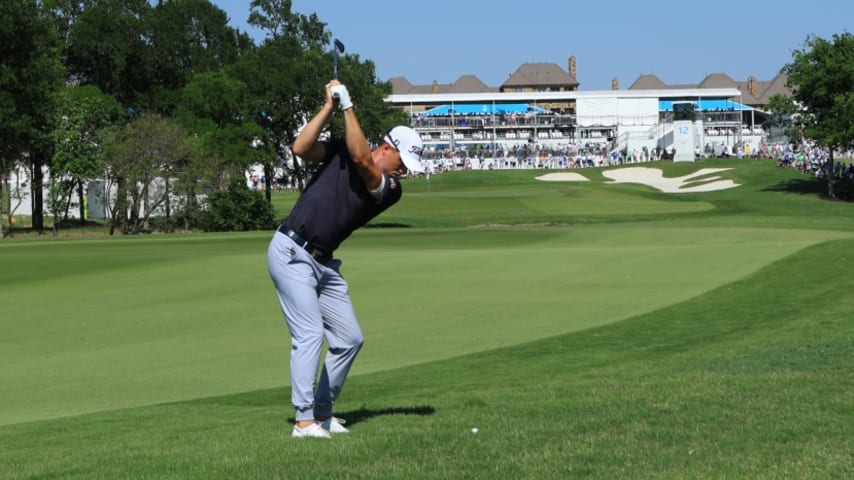Taking a closer look at the career Grand Slam
7 Min Read

Jordan Spieth could join exclusive club with victory at PGA Championship
Written by Justin Ray,
Jordan Spieth could join exclusive club with victory at PGA Championship

The best wedge shots of Jordan Spieth’s career
With only five players in history to achieve the feat, most recently Tiger Woods, winning the career Grand Slam in men’s professional golf is one of the toughest tasks in sports.
RELATED: Tee times: Rounds 1 and 2 | Tuesday notebook
Since Jack Nicklaus became the fourth member of the group at the 1966 Open, only one other player – Woods – has joined the club. Yet for the better part of the last decade, three players have been knocking on the door.
Phil Mickelson’s surprising victory at the 2013 Open Championship left only the U.S. Open remaining on his to-do list. (Easier said than done.) In 2014 and 2017, Rory McIlroy and Jordan Spieth won their third legs of the Slam at The Open, too, adding intrigue and creating a three-man Grand Slam watch that continues to this day.
While McIlroy needs to win the Masters Tournament to complete the Slam, Spieth’s next shot at it comes at Southern Hills this week, as he needs only a PGA Championship title to finish the job.
What other players have flirted with the Slam? And what traits did the five career Slam winners share?
Finishing quickly
The definition of ‘Grand Slam’ has evolved since Bobby Jones won the 1930 U.S. Open, U.S. Amateur, Open Championship and (British) Amateur Championship – golf’s four most prestigious titles at the time. That’s the old Slam. For this exercise, we’ll use the modern definition of winning all four men’s professional majors.
History shows it helps to complete the Slam early. None of the five players to finish the career Slam needed more than three opportunities to get the final leg. Three players – Gene Sarazen, Ben Hogan and Woods – won the first time they had a chance to close it out. Sarazen won his first Masters start in 1935, and Hogan famously won the only Open Championship he ever played in 1953. Woods won the third leg of the Slam in his Pebble Beach runaway in 2000, then backed it up with his first Open Championship title that summer at St Andrews.
Once the third leg of their respective Slams were secured, Gary Player and Jack Nicklaus needed just three tries apiece to complete the task, Player at the 1965 U.S. Open and Nicklaus at the Open Championship the next year. The smoke of history that plumes around a player going for the final leg again and again? Not helpful.
The timeline factor
There are 12 players who are credited with winning three of the four men’s majors that comprise the Slam. Some, like Englishman Jim Barnes, were excluded from a proper pursuit of that fourth leg simply because they were playing in the wrong era. Barnes won the three oldest majors but, alas, was 47 years old when The Masters was first held in 1934. He never competed at Augusta National.
Walter Hagen was 41 at the time of the first Masters and had already won 43 of his retroactively-credited 45 PGA TOUR titles. His best finish at Augusta was a T11 in 1936.
Tommy Armour was 37 when the first Masters was played, and retired from full-time professional golf in 1935, the year after it was founded. Still, he finished T8, his best ever Masters result, in 1937, at age 40.
Byron Nelson’s missing piece was The Open Championship, a tournament that was not held from 1940 to 1945 because of World War II. He would play in The Open only twice – in 1937 (tied for fifth), and in 1955, nearly a decade after he had retired from competing full-time professionally.
Outside looking in
In a couple of instances, a somewhat-surprising late-career major win has made finishing the Slam more unlikely. When Raymond Floyd won his U.S. Open in 1986, he was – at the time – the oldest winner in that championship’s history. Needing the Claret Jug to finish the Slam, Floyd played The Open nine times following his U.S. Open win, but never finished better than 12th.
Phil Mickelson has the most runner-up finishes at the U.S. Open, with six. But his best chances to win that championship came before he won The Open at Muirfield in 2013. Since that victory, Mickelson does not have a top-25 finish at the U.S. Open, the major he needs to join the exclusive career Grand Slam club.
At age 34, Lee Trevino claimed the 1974 PGA Championship, his first Wanamaker Trophy and the third leg of the career Slam for Trevino, who was missing only the green jacket. Trevino’s relationship with Augusta National was complicated; in his prime, he openly said he didn’t like the place. In 20 career starts, his best finishes came after he had won the first three legs of the Slam, as he tied for 10th in 1975 and again in ’85.
Closest calls
Arnold Palmer won the 1961 Open at Royal Birkdale at age 31, picking up his third leg of the career Slam. Needing only the PGA Championship to complete it, Palmer would finish runner-up three times, in 1964, ’68 and ’70. The 1968 PGA at Pecan Valley Golf Club is the closest any player has come to sealing the Slam without doing so, as Palmer had an eight-foot putt on the 72nd hole to force a playoff with Julius Boros, but missed. If you think McIlroy or Spieth might be weary from all the Slam talk, consider this: Palmer played the PGA Championship 34 times needing only that tournament to complete it.
Sam Snead finished runner-up at the U.S. Open four times, twice after winning the third leg of the Slam at the 1949 Masters. In retrospect, he lost four opportunities to win the Slam when the U.S. Open went on hiatus for World War II from 1942-1945. In 1953, Snead began the final round one shot behind Ben Hogan, but closed with 76, and Hogan ran away with his fourth U.S. Open title.
The numbers say Snead’s pursuit of the Slam was just as agonizingly close as Palmer’s, if not more so. From 1937 through 1959, there were 102 men who played 20 or more rounds in the U.S. Open. Of that group, Snead ranked fourth in Strokes Gained: Total per round (3.49) and scoring average (72.89), yet never won. In that span, he finished in the top-five seven times.
In 1982, Tom Watson, then 32, won his U.S. Open title at Pebble Beach, giving him three legs of the Slam. He headed to the PGA at Southern Hills having finished fifth, first and first in the season’s major championships, but Raymond Floyd would open with 63 that week and win wire-to-wire, while Watson tied for ninth.
Needing only the PGA to complete the Slam, Watson compiled six top-10 finishes there, including in 1993, when he was 43. One of 10 players within two shots of Greg Norman entering the final round, Watson birdied the 7th hole to get within one. Alas, that was as close as he got, finishing in fifth place. From 1982 to 1993, Watson had a scoring average of 71.8 at the PGA, a respectable 10th-best of any player in that span.
McIlroy and Spieth
Since winning The Open in 2014, McIlroy has had eight starts at Augusta National, needing only a Masters win to complete the Slam. While his best finish (runner-up) came this year, McIlroy started the final round 10 shots behind Scottie Scheffler. His best opportunities there came in 2011, when he was seeking his first major title and lost a four-shot lead with a final-round 80, and in 2018, when he was in the final pairing with Patrick Reed for Round 4. (Reed shot 1 under to win, McIlroy a 2-over 74 to tie for fifth.)
Jordan Spieth is one of three players in the modern era to have won three legs of the Grand Slam before age 24. The other two – Nicklaus and Sarazen – finished the job. This will be Spieth’s sixth start at the PGA needing it to complete the career Slam. His best finish in that stretch was a tie for third in 2019, when Brooks Koepka won wire-to-wire. Coming off a win and a runner-up in his last two starts, Spieth is riding arguably his best pre-PGA form to date with a chance to close out the Slam.
None of the five members of the Grand Slam club has taken the final leg at the PGA Championship. Already a prominent name in golf history, Spieth has a brilliant opportunity to be the first to do so this week in Oklahoma.





